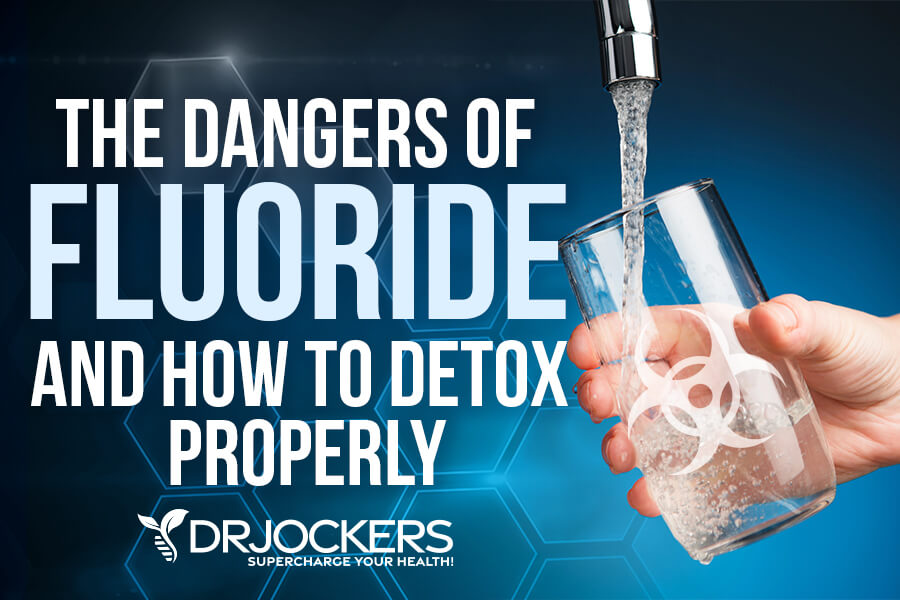 The Dangers of Fluoride and How to Detox Properly
The Dangers of Fluoride and How to Detox Properly
Fluoride has been introduced to our public tap water supply back in the 1960s for its thought-to-be benefits for dental health. For the same reason, it was also added to conventional toothpaste and many dental products. It is also hiding in some of our foods and other products we may be using.
Though all of us have been exposed to fluoride throughout our lives, it may not be a good thing. It seems like fluoride may not be such a good thing for your teeth as once believed. It also carries some other potential health risks.
In this article, you will learn what fluoride is. I will go over the sources of fluoride. You will understand how fluoride impacts your body. I will go over the potential danger of fluoride use. I will discuss whether or not fluoride is good for your teeth. I will go over the 7 research dangers of fluoride. Finally, I will share how to detox from fluoride.
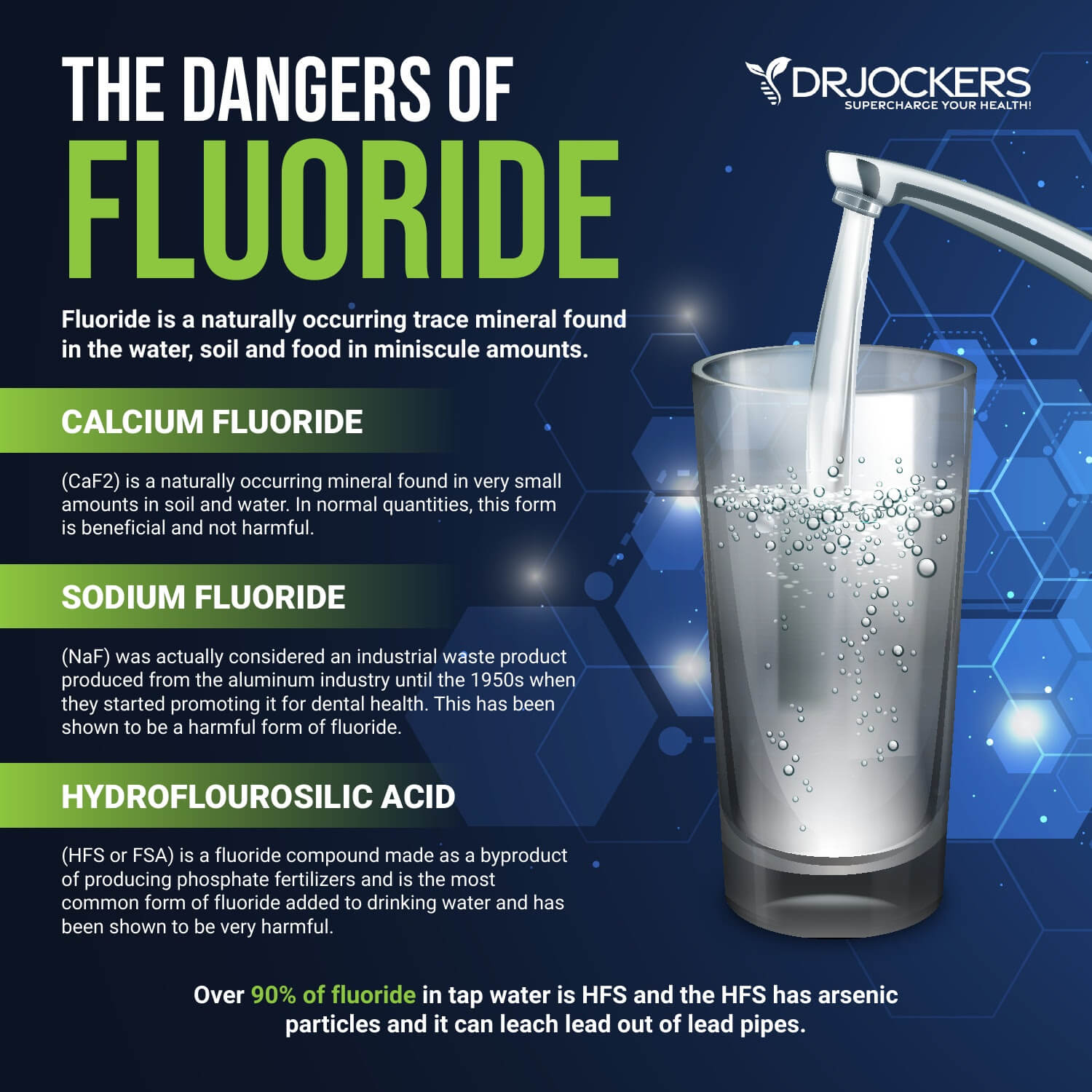
What is Fluoride?
The word fluoride is probably not new to you. You’ve seen the word on toothpaste and dental products, and you may know that it is municipal tap water. But what is fluoride?
Fluoride is one of the elements on the periodic table, you may recognize from your school days. The chemical symbol of fluorine is “F” and its atomic number is 9. Fluoride is basically the catch-all term for any compound with fluorine ion. In a pure gas form, fluorine is extremely damaging to living organisms, as it’s very reactive and electronegative to other elements. However, it’s not the only form, in fact, it’s not the form we are talking about when we say fluoride.
Calcium fluoride or CaF2 is a form of fluoride, a naturally occurring mineral found in soil and water. For example, spring water contains around 0.01 – 0.03 ppm, and seawater about 1.3 ppm fluoride. Of course, this also depends on the location. Some water supplies may contain up to 10 to 20 ppm of calcium fluoride, which is unsafe for consumption.
Calcium fluoride, which doesn’t absorb well in the human body, is not the fluoride added to our tap water. It’s sodium fluoride of NaF instead. At least, in the past, this was the case, but more on that later. Sodium fluoride does not occur in nature, and it does absorb into the human body.
What you need to know is that sodium fluoride was actually considered an industrial waste until the 1950s when they started promoting it for dental health. In 1945, the government started comparing the cavity levels in children and adults in various US cities and comparing the results to whether they were drinking fluoridated or unfluoridated water. According to the Centers for Disease Control and Prevention (CDC), dental issues were reduced by 50 to 70 percent in communities drinking fluoridated water during the 13 to 15 years of the observation (1).
We have no data about the control group drinking unfluoridated water and whether their cavities increased or decreased during this time. We also don’t know if this decrease was directly correlated to fluoride or had other reasons (2). Nonetheless, the US started promoting the US of fluoride to prevent cavities.
According to the CDC, as of 2020, 72.7 percent of people in the US receive water from water system with fluoridated water (3). Back in 2014, this number was 74.4 percent, so this number is slightly decreasing due to community effort to remove fluoride from our tap water.
Another interesting fact is that today, most of the fluoride in tap water is not calcium fluoride nor sodium fluoride, but 90 percent is from hydroflourosilic acid (HFS or FSA), which is a by-product of making phosphate fertilizers (4). Needless to say, hydroflourosilic acid is considered a toxic waste, yet it’s still in our water. In 2013, the Environmental Protection Agency (EPA) received a petition to remove HFS from municipal tap water due to its potential toxic effects on human health (5).
One of these health risks may be due to the presence of arsenic. You may be surprised to hear that arsenic is allowed at 0.010 ppm in our water supply, according to the EPA, despite the fact that arsenic is potentially a cancer-causing agent (6).
Moreover, HFS may leach lead from the pipes, which may cross the blood-brain barrier easier than other types of fluoride, which can be especially risky to pregnant mothers, unborn babies, newborns, and young children (7, 8). Needless to say, fluoride in our municipal tap water is clearly problematic, and I will go into the specific health risks later in this article.
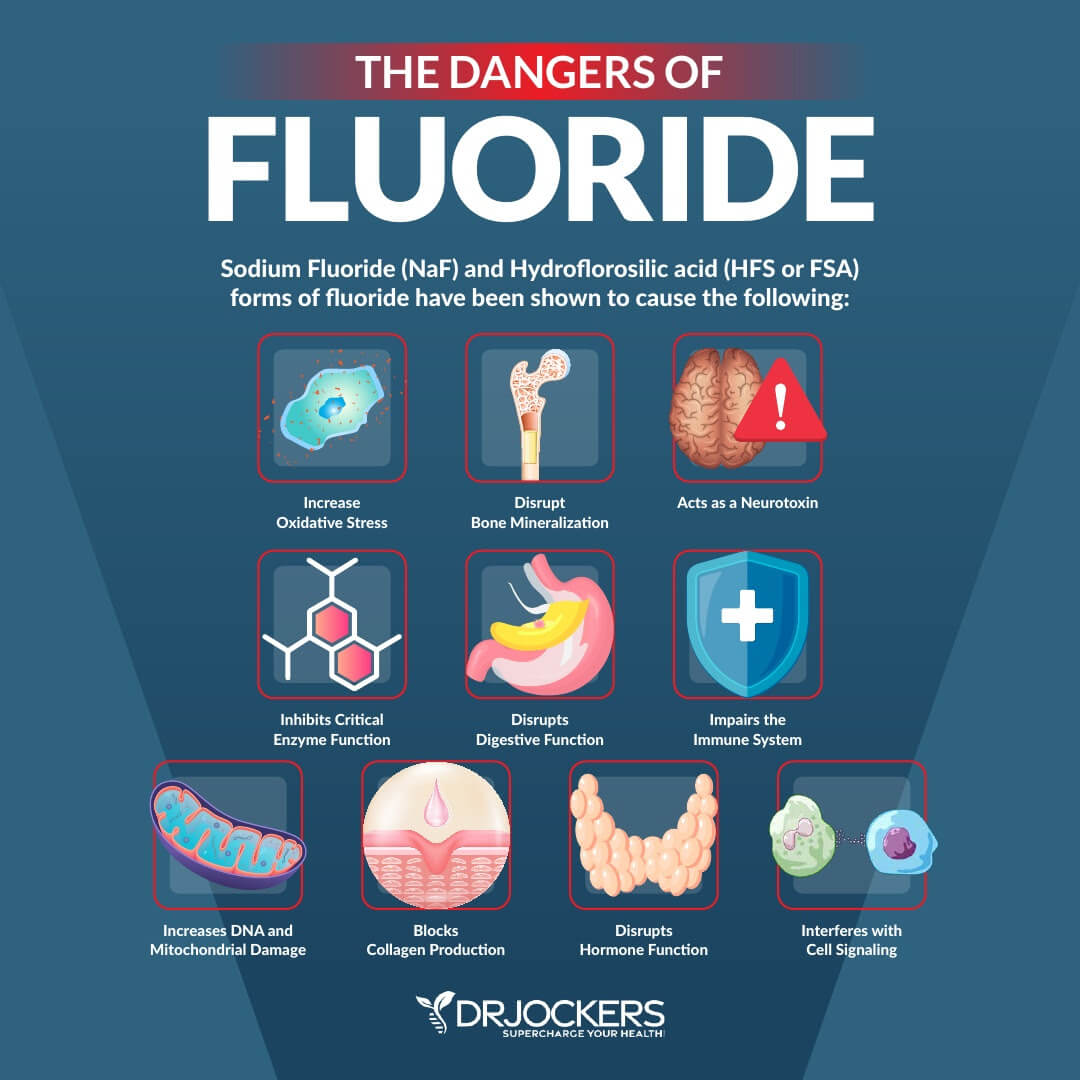
Sources of Fluoride
Most people know that toothpaste and tap water contain fluoride. But did you know that fluoride may be hiding in many foods and other items in your home? Let’s look at potential sources of fluoride.
Dental sources of fluoride:
- Fluoride toothpaste
- Fluoride mouthwash
- fluoride varnishes
- Fluoride gels, both professionally and self-applied
- Fluoride supplements
Food sources of fluoride:
- Dill pickles
- Canned tomato products
- Bottled fruit juices
- Sodas and other carbonated vegetables
- Canned corn
- Canned beets
- Canned sauerkraut
- Spinach
- Carrots
- Radishes
- Celery
- Asparagus
- White potatoes
- Onion rings
- White rice
- Peach nectar
- Apricot nectar
- Canned soup
- Certain baby food
- Teas
- Some alcoholic drinks
- Boxed cereal
- Dry mix cakes and other desserts
Pesticide sources of fluoride:
- Cryolite, in grape products and some GMO vegetable and fruit crops
- Sulfuryl fluoride in food processing factories
Other sources of fluoride:
- Teflon pans
- Medications, including anesthetics, statin drugs, anti-inflammatories, flecainide, niflumic acid, cipro, and voriconazole
- Workplace exposure to fluoride
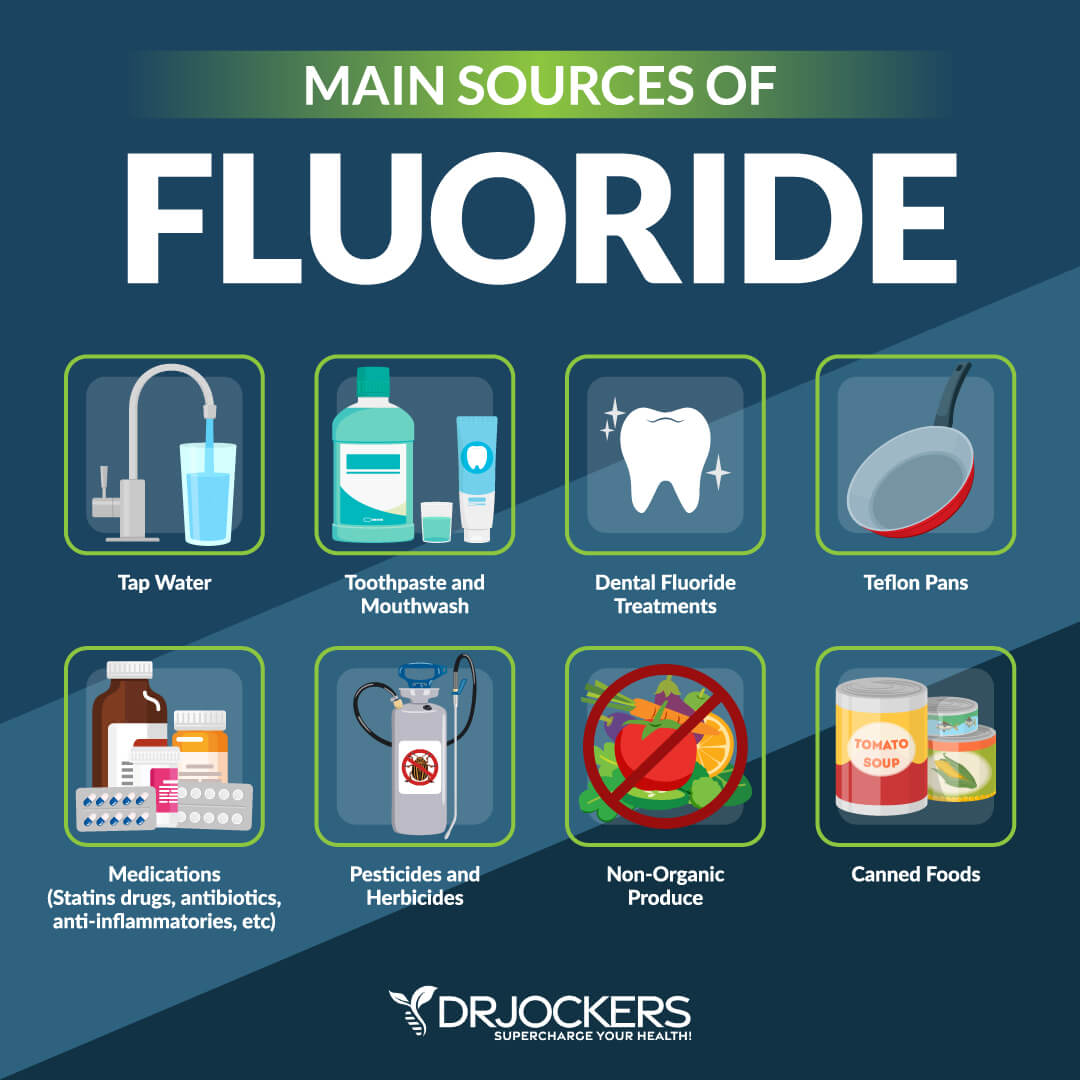
How Does Fluoride Impact the Body?
Let’s get into how fluoride may impact you once it enters your body. If fluoride enters your body, it can pass through the blood-brain barrier. The blood-brain barrier helps to protect your brain and nervous system from toxins, pathogens, and other invaders from passing through.
Fluoride can bioaccumulate in your body. This means that your body won’t be able to metabolize and release all of it as waste. While about half of the fluoride that gets in your body through water, food, or other means may get released through urine, the other half may be accumulated in your bones, teeth, and other calcified areas of your body. If your urine is alkaline, it may be able to remove more fluoride than acidic urine (9).
But it’s not only your bones and teeth that are affected. Fluoride may build up in your pineal gland, where melatonin is secreted. This may affect your sleep and circadian rhythm. According to a 2001 study published in Karger, older individuals may have a higher calcium-to-fluoride ratio in their pineal gland than in their bones, which may explain calcification of the pineal gland and reduced melatonin production as we age (10).
As I mentioned earlier, fluoride can leach onto lead from water pipes, which may lead to further issues. A 2000 study published in Neurotoxicology has found that children exposed to HFS fluoridated water tend to have higher levels of lead in their bloodstream (11). This study has also shown that sodium fluoride and HFS are not the same. HFS may be more dangerous and may increase the risk of lead toxicity, especially in children living in older homes.
Since fluoride can pass through the blood-brain barrier system, it can also accumulate in your brain and cause various issues. A 2014 study published in Toxicology Mechanisms and Methods has found that an increase in sodium fluoride may cause fluoride deposition the brain tissue, which may increase levels of histamine, glutamate, epinephrine, and serotonin, and lower levels of dopamine, norephrine, and acetylcholine (12). This study was an animal study done on rats. Rats are not as sensitive to fluoride as humans are.
The study was not only done on rats that are less sensitive than humans but with sodium fluoride, which is less dangerous than HFS. This makes one wonder about the risks of HFS for the human brain and other areas of human health.
Though we need more research to completely understand the health risks of fluoride, it seems clear that fluoride may affect your brain and neurological health, metabolic energy systems, and sleep (13). As you will learn in the next sections, fluoride carries a variety of dangers and health risks and may not even be as good or necessary for your dental health as your dentist has been telling you.
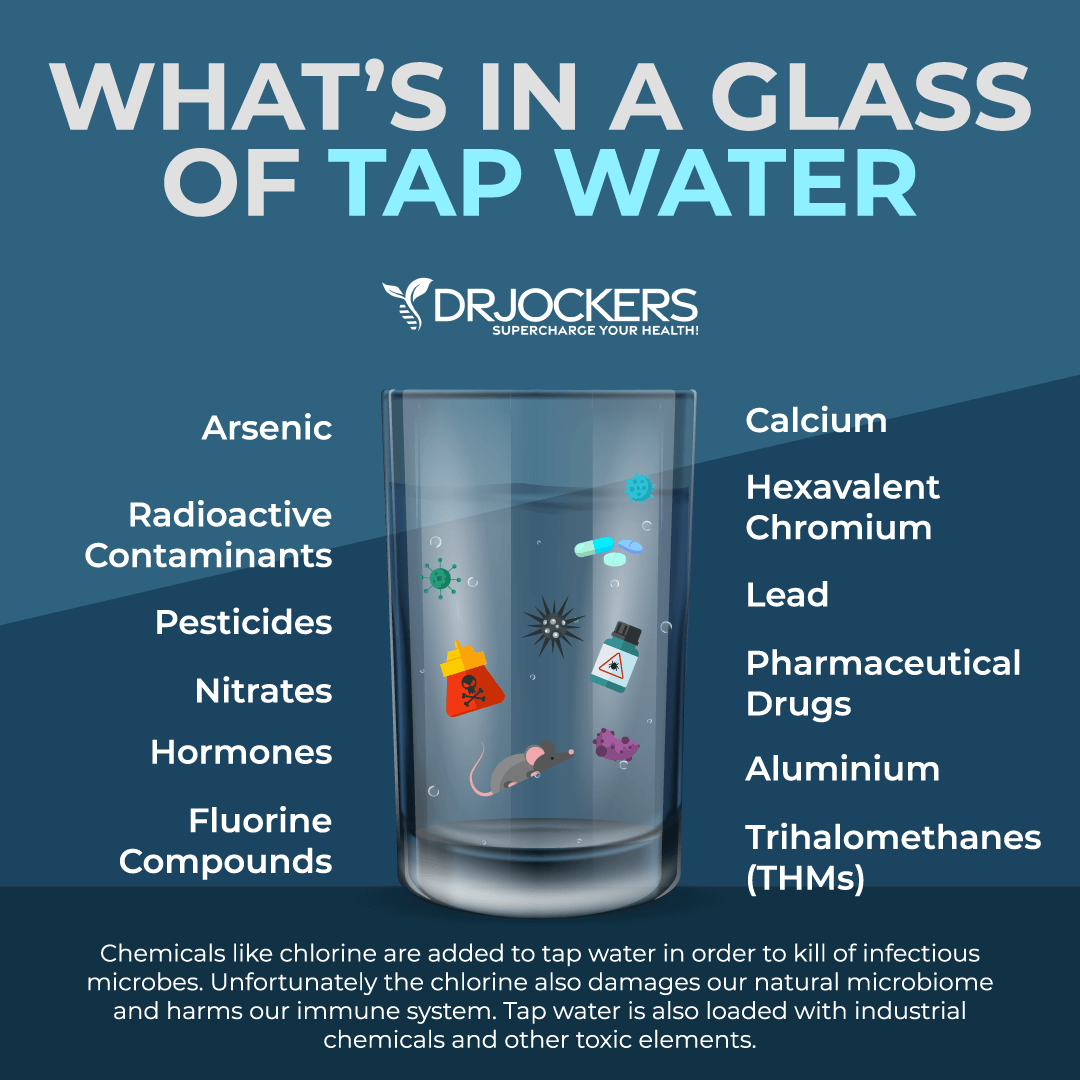
Dangers of Fluoride Use
Is fluoride safe for you? It depends on who you ask. According to the CDC, fluorosis is the only danger of fluoride (14). Dental fluorosis refers to the visible changes to the enamel surface of the tooth from fluoride used in dental treatment.
According to governmental guidelines, the minimal risk level is 0.0228 mg per pound of body weight (15). This means that for a 160-pound person, this minimal risk level would be 3.65 milligrams per day.
If this person drinks 10 glasses or 80 ounces of fluoridated tap water a day, they will intake 1.66 milligrams of fluoride a day. This is from water alone. Adding in foods, drinks and dental products and other sources and this will be over the recommended limit. Not to mention that people with dental issues are often recommended prescription toothpaste and dental care with more fluoride than conventional fluoridated toothpaste.
Looking at this, we may have more on our hands than cosmetic issues from fluorosis. You will learn later in this article that brain issues, sleep disruption, metabolic problems, bone fractures, and other health risks may occur related to fluoride issues. Yet, these risks are not included in governmental guides besides the increase in bone fractures in the elderly, which was added only recently (16).
Not listing these risks on governmental websites, of course, doesn’t make these issues go away. There is a growing number of health professionals that warn against fluoride and research on the health risks is increasing. In the UK, the NHS Centre for Reviews and Dissemination has looked at the potential cancer risks of fluoride and stated their concern on the lack of high-quality research on public water flouridation (17).
A 2006 study report and review by the National Research Council, titled “Fluoride in Drinking Water: A Scientific Review of EPA’s Standards,” has found a number of health risks that we need to take seriously and conduct more research on (18).
They found that individuals at higher risk include infants, children, outdoor workers, athletes, people with poor kidney function, diabetes insipidus, and other health conditions. They found that fluoride may impact the central nervous system, endocrine system, and other areas of health, however, we need more research.
EPA Union members and medical professionals that signed the Fluoride Action Network’s petition have urged the EPA to change their position of flouridated water and speak up against flouridation (19, 20). As a result of these efforts and new evidence on the risks of fluoride toxicity, the US Food and Drug Administratol (FDA) has started requiring addeding a warning label on fluoride toothpaste on the risks of fluoride toxicity (21).
However, this is far from enough, and we need more efforts to fight against flouridation in water and dental products. Removing silicofluorides and HFSA is especially important, as it has much higher risks that sodium fluoride (22). However, regardless of the kind of fluoride, you probably want to be conscious of any exposure and protect your body against it.

Is Fluoride Good For Your Teeth?
The main reason fluoride was introduced to our water system and dental products is to support the health of our teeth. But is fluoride actually good for your teeth?
Fluoride does have a role in the demineralization and remineralization of your teeth (23). Some foods may remove some minerals from your teeth (demineralization) and fluoride may help to remineralize and calcify your teeth and lower the risk of cavities. Since most families rely on municipal tap water for hydration, adding fluoride to water might seem like a smart solution to dental issues, especially in children and low-income families.
Some research, including a 1993 review published in Caries Research and a 2012 research published in Community Dentistry and Oral Epidemiology, suggests that fluoridation may help to reduce dental issues (24, 25). However, according to a 2000 review published in BMJ, these effects may only be low to moderate (25).
The potential effects of fluoride on teeth were first discovered by Frederick McKay, a dentist who noted that fluoride may cause discoloration to teeth (26). He also noted that these fluoridated discolored teeth seemed more resistant to tooth decay.
The interest in fluoride has grown and some studies found that water naturally high in fluoride may help to strengthen teeth but may also cause mottled enamel, which is flat, white, or yellow, or even brown, black, and corroded (27). This is now known as dental fluorosis, which is considered a cosmetic issue, mainly affecting children’s ‘baby teeth’.
However, this is not the only form of flourosis. Crippling skeletal fluorosis is a serious issue from water with naturally extremely high fluoride levels. This may affect bone rigidity and range of motion and mainly affects people in third world countries (28).
Though dental flourosis is considered cosmetic, it is worth noting that according to the CDC, rates are rising in the US, which is probably contributed to increased fluoride in our water and dental products (29). Though according to 1998 research published in the Journal of Public Health Dentistry, communities with fluoridated water tend to have fewer cavities than those without (30).
However, the gap is closing. It seems that countries and communities with fluoridated water see a similar decline in tooth decay than those without public water fluoridation practices (31, 32).
This makes us question if fluoride in water is even necessary or beneficial or if the rate of decline in tooth decay may not be from fluoride at all. According to Nobel Prize winner Dr. Arvid Carlsson, using fluoride topically may offer some benefits, but using it by ingesting it may not be beneficial (33).
Considering the potential health risks of fluoride and the little to no benefits of fluoridated water on our dental health, avoiding fluoride may be in our best interest. Yet, the US government still recommends fluoridated water, and in the UK Department of Health recommends the fluoridation of water, milk, and salt for dental cavities (34). In the US, milk and salt are not fluoridated, but our tap water and conventional dental products are.
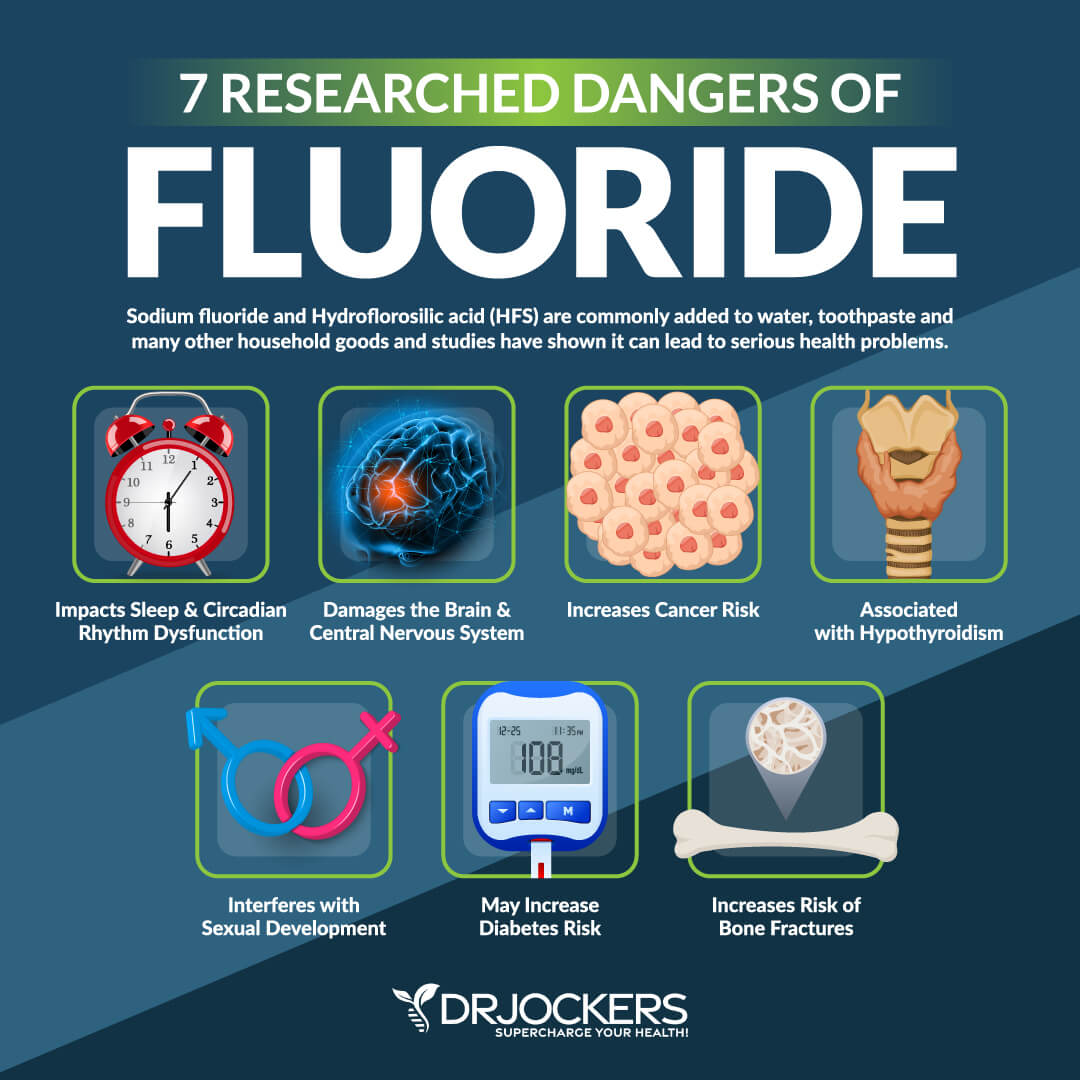
7 Researched Dangers of Fluoride
Fluoride has a list of potential health risks for your body, and many of these risks have scientific research behind them. Let’s look at the 7 researched potential dangers of fluoride.
1) Impacts Sleep & Circadian Rhythm Function
As I mentioned earlier in this article, your pineal gland produces melatonin. Melatonin is a hormone that helps establish healthy sleep patterns and supports your circadian rhythm. The problem is that fluoride can build up in your pineal gland and disrupt your sleep and circadian rhythm.
According to a 2001 study published in Karger, older individuals may have a higher calcium-to-fluoride ratio in their pineal gland than in their bones, which may explain calcification of the pineal gland and reduced melatonin production as we age (10).
A 2019 study published in Environmental Health has found that fluoride exposure may affect the sleep patterns of older teenagers (35). It may result in falling asleep later, waking up earlier, and developing sleep apnea. A 2021 study published in Environmental Health has found fluoride exposure may reduce sleep duration and quality in older adolescents and adults (36).
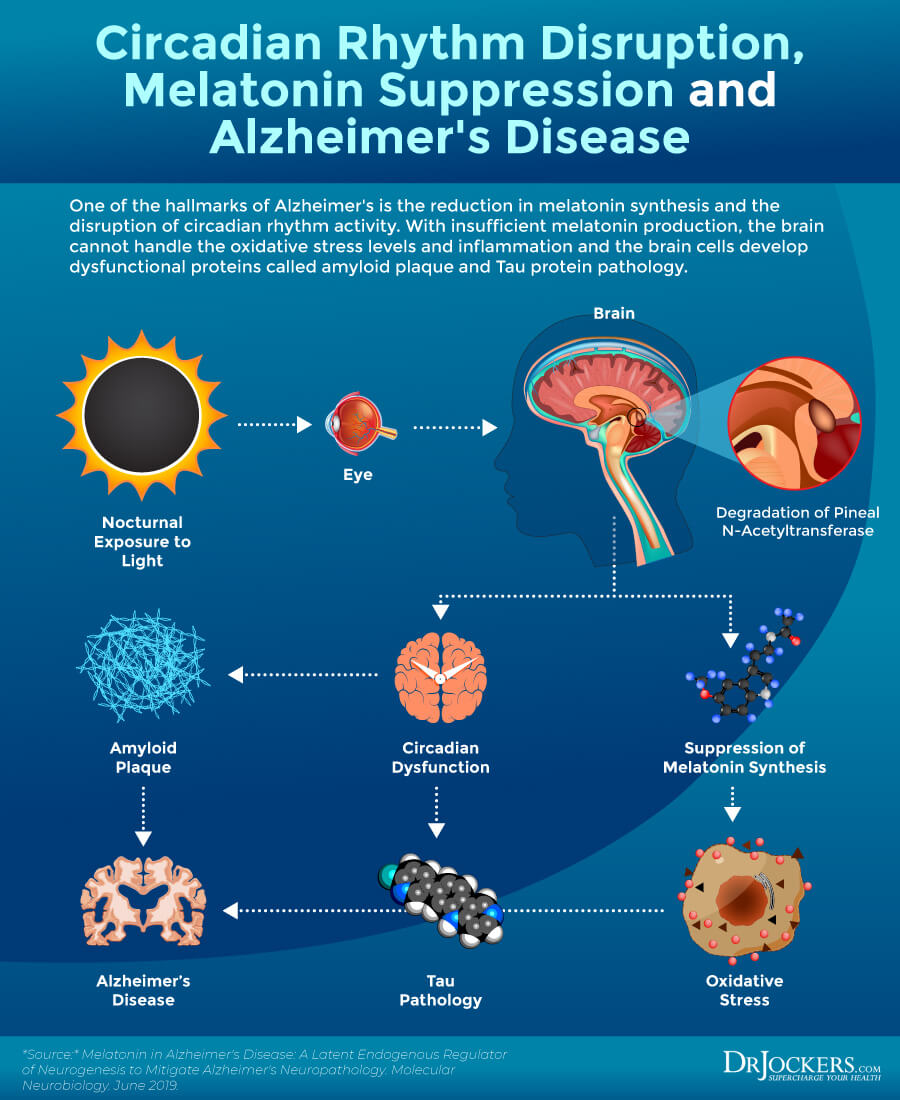
2) Damages the Brain & Central Nervous System
Another major risk of chronic fluoride exposure through ingestion is its negative effects on your brain and central nervous system (CNS). Research on this started decades ago. A 1995 study published in Neurotoxicology and Terratology has found that rats exposed to fluoride at various ages was affected (37). They noted sex- and dose-specific behavioral deficits, brain differences, hyperactivity, and cognitive deficits.
A more recent 2017 study published in Environmental Health Perspectives, has found that fluoride exposure may cause IQ disparity up to 2.5 to 7 point difference in children with chronic exposure to fluoridated water compared to those that were not exposed to fluridated water (38). An earlier, 2015 study published in Neurotoxicology and Teratology has found also found that dental fluorosis may be correlated with lower IQ scores (39).
A 2023 paper published in Materials (Basel) has found that fluoride may affect your brain and neurological health (13). As we already discussed, fluoride can cross through the blood-brain barrier. According to a 2021 literature review published in the International Journal of Environmental Research and Public Health, fluoride may affect your neurotransmitters and thus impact your normal brain chemistry (40).
Fluoride may also increase your risk of dementia. 2006 study research published in the Annals of New York Academy of Sciences has brought up some concerns that fluoride exposure may be among the risk factors for developing Alzheimer’s disease due to its toxic potential on the nervous system and cerebrovascular and neural integrity (41).

3) Increases Cancer Risk
fluoride exposure may also increase the risk of developing certain cancers. 1977 study published in the Official Quarterly Journal of the International Society for Fluoride Research compared 10 large fluoridated and unfluoridated cities (42). They noted that cancer-related deaths were 18 percent higher in fluoridated communities compared to non-fluoridated one. They speculated that there were 3,000 more cancer-related deaths per 10,000 million due to fluoride.
Another 1977 study published in Fluoride noted that there were 1,500 more cancer deaths per 10 million people between ages 45 and 64 and 3,500 more cancer-related deaths per 10 million people in individuals over age 65 in fluoridated communities compared to unfluoridated ones between 1952 and 1969 (43).
According to a 2001 review published in the Journal of Epidemiology, cancers affecting the pharynx, oral cavity, hepato-biliary system, urinary system, colon, and rectum, as well as bone cancer, lymphomas, brain tumors, melanoma, and monocytic leukemia may be among the highest risk due to fluoride exposure (44).
A 1993 study published in the Official Quarterly Journal of the International Society for Fluoride Research has found that fluoride might’ve increased the risk of osteosarcoma in men under 20 by 6.9 percent in the three-county area they studied (45). That said, these studies have older data, and relatively few other studies since have found no significant increase in cancer in fluoridated communities compared to non-fluoridated ones (46, 47, 48).
We clearly need more research to understand the link between fluoride and cancer. However, protecting your health is never a bad idea, even if there is only a small risk.
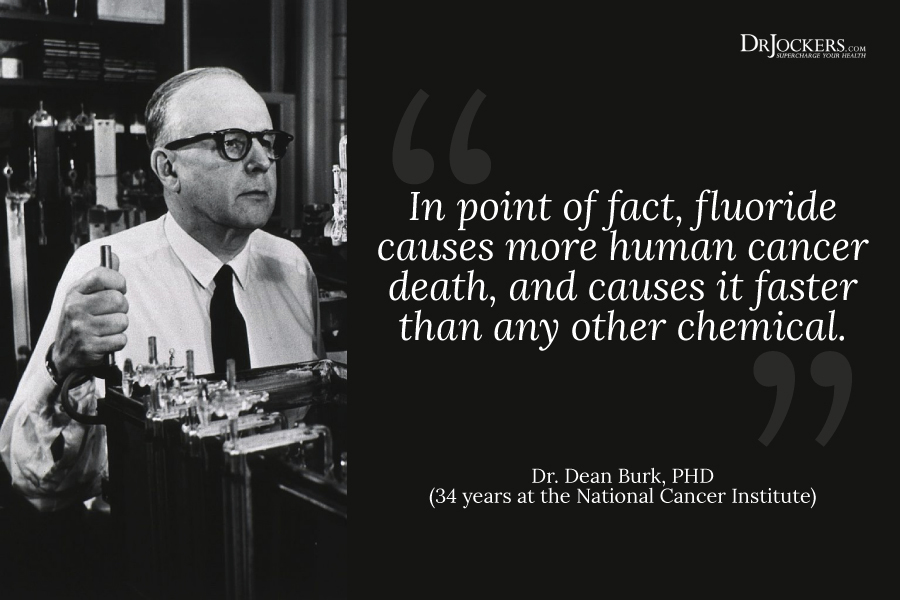
4) Associated with Hypothyroidism
Hypothyroidism means that your thyroid is not making enough thyroid hormones. Chronic fluoride exposure may affect your hormonal function and thyroid health. It may increase your risk of hypothyroidism.
A 2015 study published in the Journal of Epidemiology and Community Health has found that people living in areas without fluoridated water had a two times lower risk of developing hypothyroidism compared to those living in areas with fluoridated water (49). A 2024 study published in Environmental Research has found that fluoride exposure from water may increase the risk of hypothyroidism and goiters in both children and adults (50).
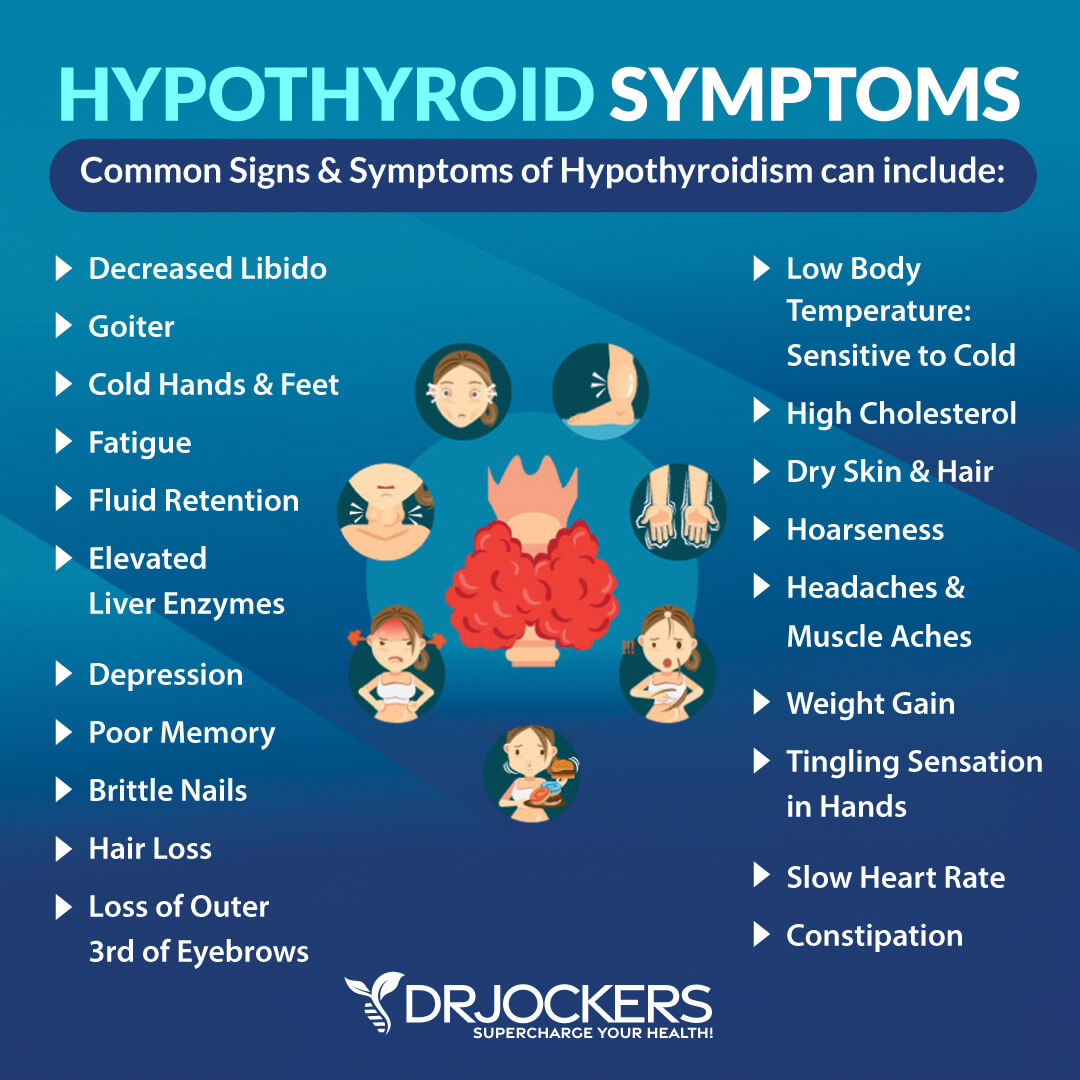
5) Interferes with Sexual Development
fluoride may also interfere with sexual development. A 1997 PhD dissertation study at the University of Surrey has found that fluoride exposure may result in faster sexual development in females (51). Since puberty is becoming earlier and earlier and early puberty in females may also increase the risk of breast cancer, this may be an important finding.
On the other hand, according to a 2019 study published in Environmental Health, fluoride exposure may delay puberty in males (52). Researchers found that it may be linked to later genital development and pubic hair growth.
A 2020 study published in Environmental Pollution has found that fluoride exposure may affect sex steroid hormones, lower testosterone levels, and reduce estradiol levels in adolescent males and may negatively impact sex hormone binding globulin (SHBG) in adolescent males and female children (53).
Fluoride has been shown to impact all the major endocrine organs and cause dysfunction within all hormones (54). This impacts thyroid function, stress response, insulin secretions and sexual development.
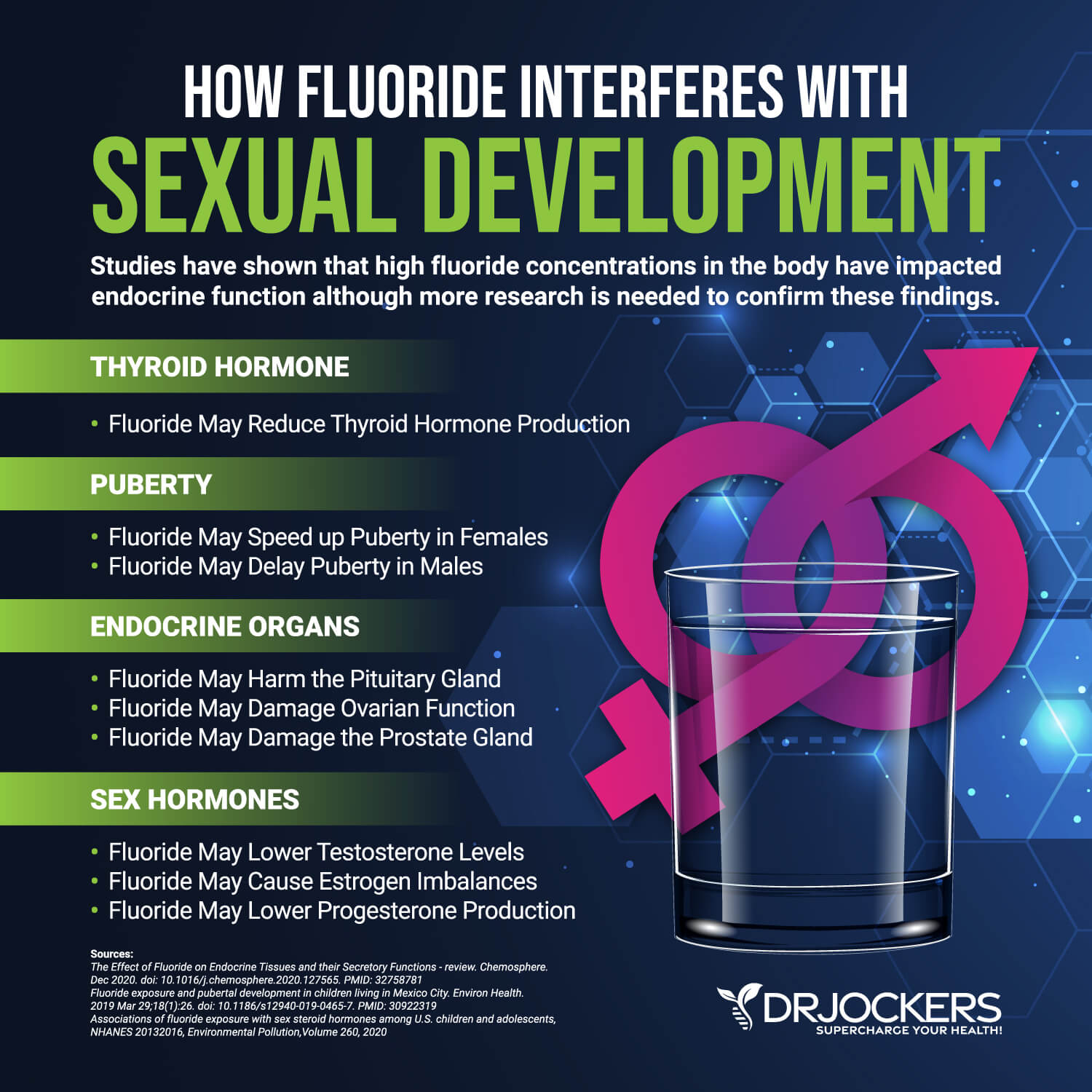
6) May Increase Diabetes Risk
Diabetes affects almost 12 percent of the population (55). This doesn’t include those with prediabetes, insulin resistance, and blood sugar imbalances. It is among the top health concerns, and diagnoses are ever-increasing and at an all-time high.
While there is a long list of factors that may contribute to the risk of developing diabetes, fluoride exposure may be among them. A 2015 report by Dr. Geoff Pain, an Australian chemistry specialist, has stated that fluoride may increase the risk of diabetes (56).
A 2015 study published in the Journal of Dental Research has found that water with lower levels of fluoride may help to lower insulin resistance and support glucose homeostasis compared to high-fluoride water (57). That said, we still need more research evidence to completely understand the potential risk of fluoride on insulin resistance and diabetes.
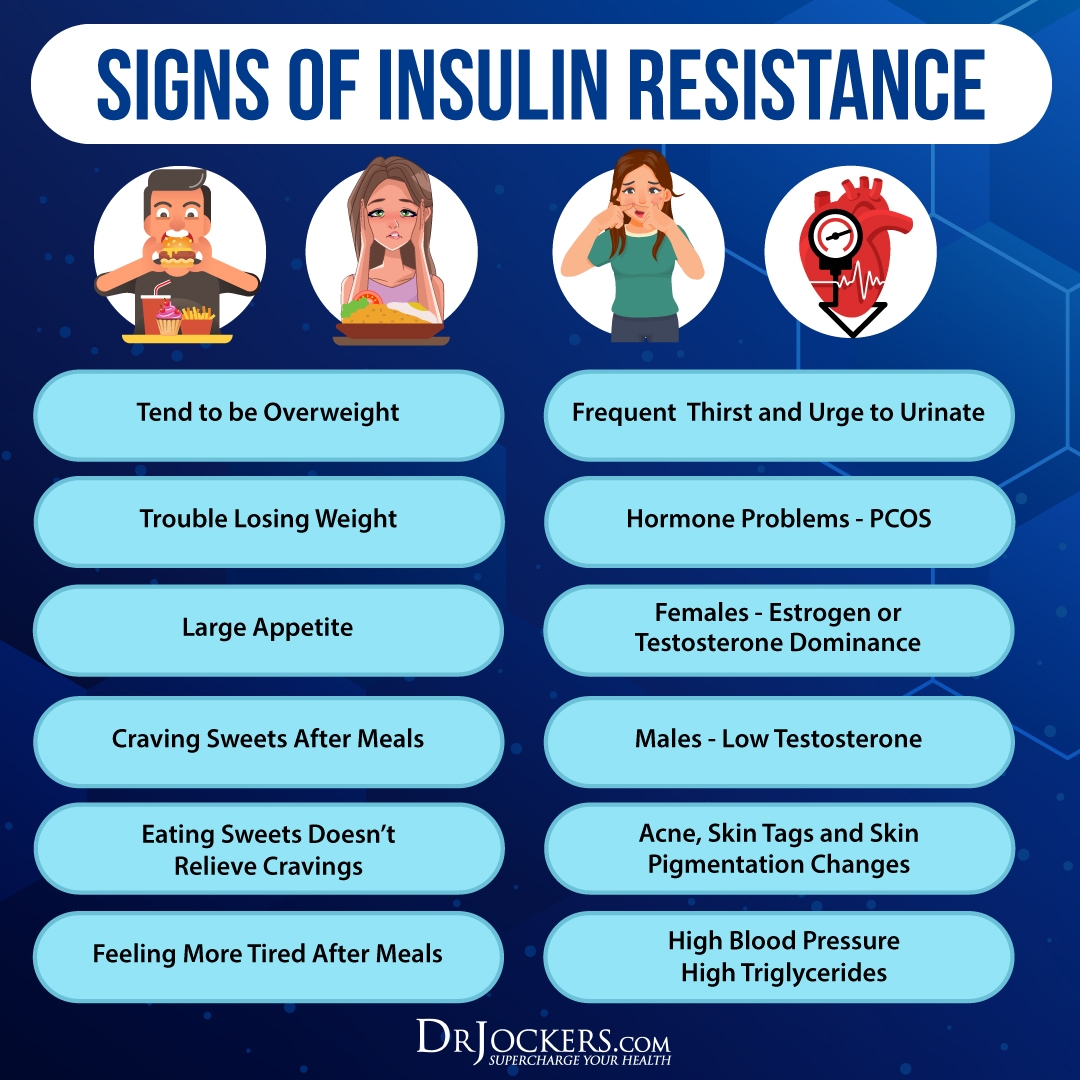
7) Increases Risk of Bone Fractures
Though fluoride was originally added to our water systems and dental products to improve the health of our teeth, ingesting fluoride may not be great for our bone health. According to a 2001 study published in fluoride, fluoridated water exposure and ingestion may increase the risk of bone fractures in children.
We have already discussed the potential link between tooth damage and ingesting fluoride earlier in this article (33, 34). However, this research has also found that fluoride ingestion may also increase the risk of major tooth damage in children (57).
A 1992 study published in JAMA has found that drinking fluoridated water regularly at 1 ppm may increase the risk of hip fractures in older individuals (58). That said, there have been other studies that found no evidence that fluoridation may increase factures or osteoporosis (59, 60). We need more research to understand the potential relationship between fluoride ingestion and bone health.
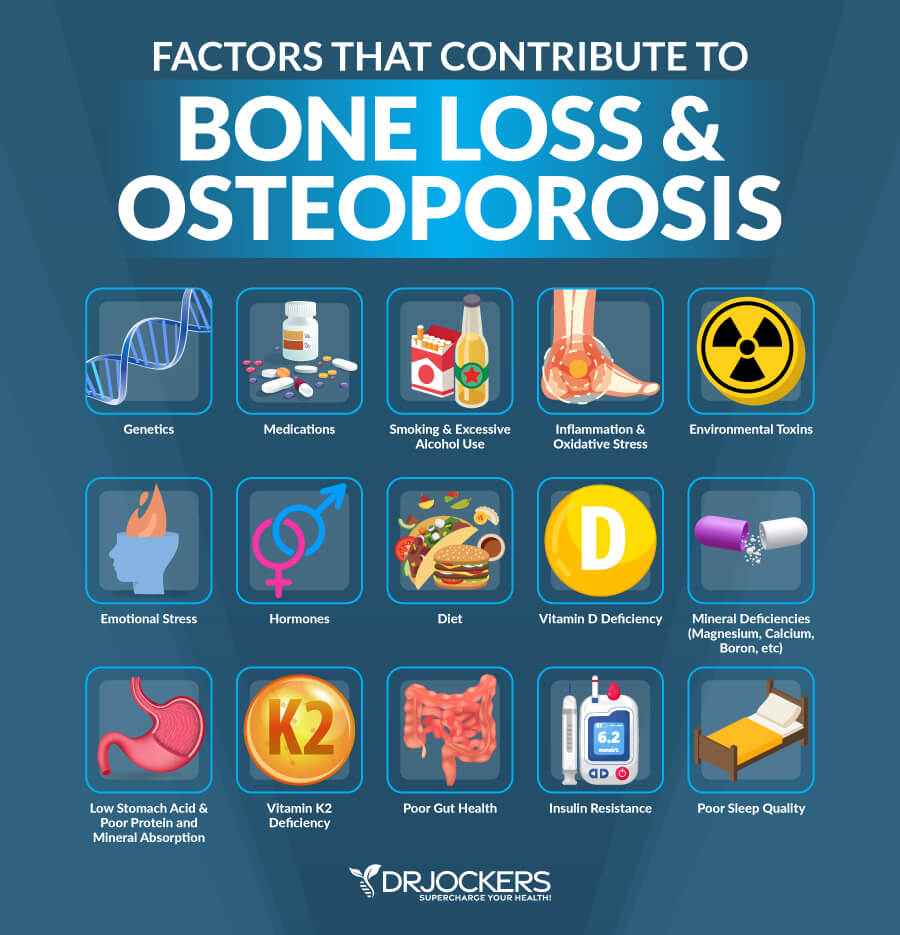
How to Detox Fluoride
Now, you understand the potential risks of fluoride exposure. However, most of us have been or are currently exposed to fluoride.
If you are drinking tap water and using conventional toothpaste and dental products, your exposure level is likely quite high. So what can you do about this? Let’s discuss how to detox from fluoride. Here are my best tips.
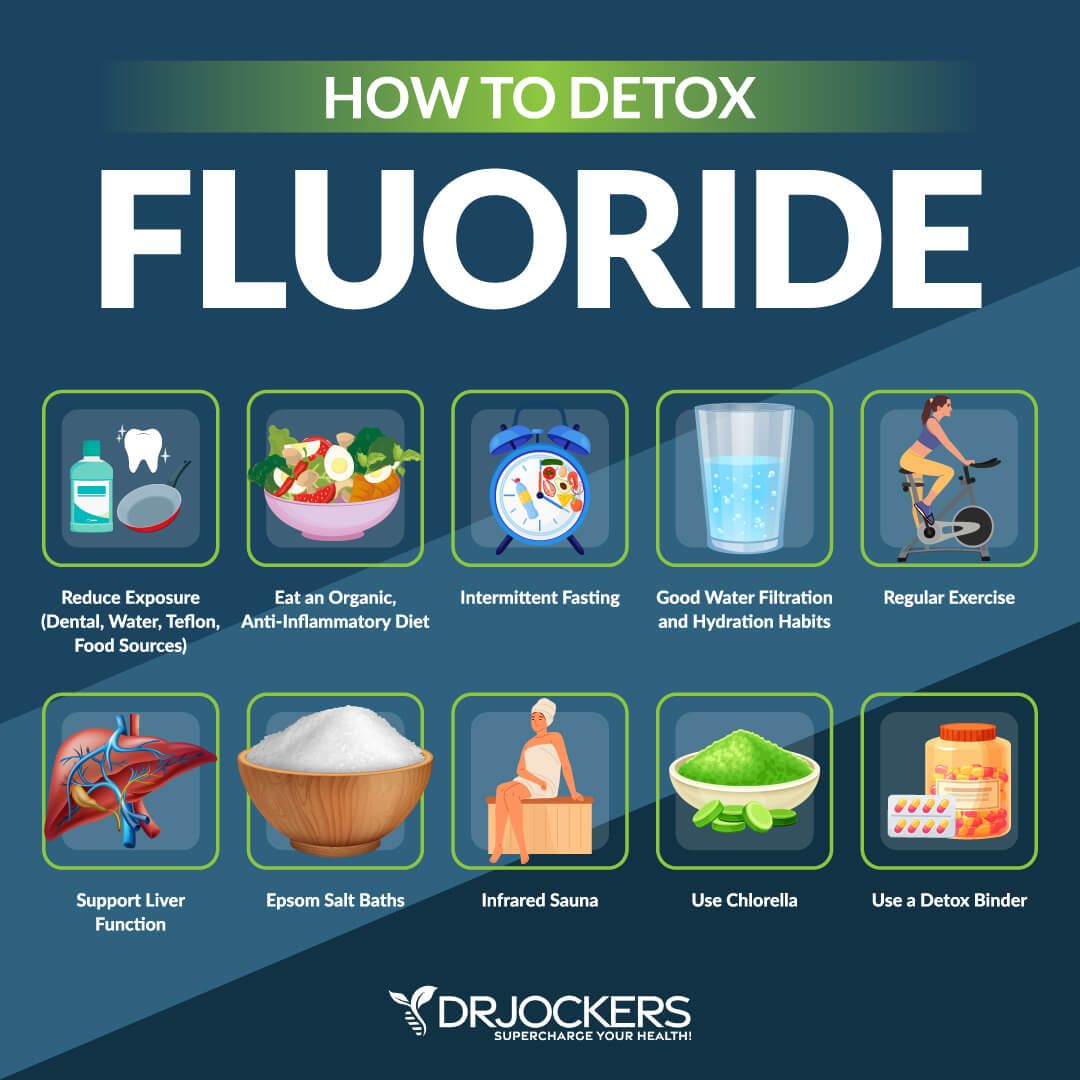
Reduce Exposure
Reducing fluoride exposure is the first step for reducing fluoride-related health issues. Avoid drinking tap water. Even if you are living in a unfluoridated area, tap water is full of other chemicals that you want to avoid. Invest in a high-quality water purification system.
Spring water may also be an option, especially if you are not at home and must purchase water. Ideally, you want to avoid plastic bottles though. Choose spring water packaged in glass or paper bottles.
Avoid using conventional toothpaste and dental products with fluoride. Avoid fluoride treatment at your dentist and seek biological dental care instead of conventional dentistry. Choosing organic when it comes to food with a potential risk of fluoride exposure is also critical. Check the list earlier in this article.
Avoiding fluoride ingestion when pregnant or nursing is especially important as you can pass fluoride to your child while in the womb or through nursing. Remember, they are even more vulnerable than us adults.
Finally, take action in your community. Sign petitions. Vote according locally. Participate in the conversation.

Eat an Organic Anti-Inflammatory Diet
I recommend following an organic, anti-inflammatory, nutrient-dense diet. Avoid refined sugar, refined oils, artificial ingredients, additives, and anything overly processed.
Choose organic greens, vegetables, herbs, spices, sprouts, fermented foods, fruits, nuts, seeds, grass-fed beef, pasture-raised poultry, pasture-raised eggs, wild-caught fish and seafood, and wild-game. Trace mineral rich foods may also help detoxification.
Choose organic whenever possible and available. If you can’t eat completely organic, remember the Dirty Dozen and Clean 15 list. Foods on the Clean 15 list may be bought non-organic, but you still have to wash it well and peel it. If the food is on the Dirty Dozen list or it’s at risk of fluoride exposure (see the list from earlier), buy organic.

Intermittent Fasting
Intermittent fasting is a way of eating when you are cycling between periods of fasting or feasting. Intermittent fasting is a great strategy to reduce inflammation, improve insulin resistance, support cellular autophagy, and reduce your risk of chronic symptoms and health issues.
If you are new to intermittent fasting, start with 12 hours of fasting, including your overnight sleep. For example, if you eat dinner at 6 pm, stop eating after 12 hours, and you will be ready to eat again at 6 am the next day. Increase your fasting period over time.
You will notice that delaying breakfast until 7 am, 8 am, or even 10 am will come naturally to you over time. Most people feel the best with 16 hours of fasting a day. It’s critical that you eat nutrient-dense, anti-inflammatory foods and meet your caloric needs during the eating period. To learn more about intermittent fasting, I recommend reading this article.

Good Water Filtration & Hydration
Good hydration is critical part of detoxification and eliminating toxins. It’s also essential for all areas of your health. What kind of water you drink matters though, especially when you are trying to avoid and detoxify from fluoride.
Invest in a high-quality water filtration system. Not all water filtration systems are the same, though. There are three different home water filtration systems that can filter out fluoride. These include reverse osmosis, activated alumina, and deionizers. Activated carbon filters, which are popular on the market, don’t filter out fluoride. Steam distillation may also remove fluoride, but it can also remove beneficial ingredients from your water.
I recommend systems like Aquatrue or the Berkey system for low-cost filtration. The best water is the UltraLux Triple Action Hydrogen Water Machine which is what I use at home as it is powered by molecular hydrogen which reduces oxidative stress in the body and improves immune function.
Once you have the right water source, hydrate your body well to support hydration and detoxification. Start your day with 16 to 32 oz of water. You may add some apple cider vinegar or lemon juice to kick-start your digestion.
Drink about one glass every hour. You may add lemon juice, berries, mint, or other herbs for taste and added nutrients. You may support your hydration with herbal tea, green juices, green smoothies, and hydrating vegetables and fruits.

Regular Exercise and Movement
Regular exercise and movement can help to remove toxins through sweating. It may also help to reduce inflammation and support digestion and elimination. According to a 2013 study published in the Journal of Endocrinology, exercise may also help to reduce fluoride levels of rates and lower the risk of negative health effects of fluoride, such as insulin resistance (61).
I recommend moving your body throughout the day and exercising at least 5 days a week. To lead an active lifestyle, make sure to get up from your desk to stretch and walk around, add outdoor activities to your life, walk or bike instead of driving when it’s possible, take the stairs, try an impromptu dance session, try rebounding, play with your kids, walk your dogs, and generally, try not to sit around.
For exercise, I recommend a mix of resistance and strength training, cardiovascular activities, and low-impact workouts. High-intensity interval training (HIIT) is a great way to get the benefit of cardio, strength training, and resistance training in one.

Support Liver Function
Supporting liver function is critical for detoxification. One way to do this is by using castor oil packs. Castor oil packs have been around since ancient Egypt. They may help to support circulation of the blood around your liver, push the flow of fluids in your lymphatic system, and support detoxification. You can learn more about castor oil packs here from this article.
Other strategies that may improve liver function include herbs and foods, such as lime, lemon, artichokes, apple cider vinegar, mint, parsley, cucumber, celery, dandelion, milk thistle, cilantro, radishes, ginger, turmeric, green tea, and sauerkraut.
You can learn more about liver detoxification from this article and this article. You may also try KL Support. This supplement combines herbs and nutrients traditionally used to support kidney and liver health, including beetroot, collinsonia (stoneroot), gynostemma, marshmallow root, milk thistle seed, NAC, and parsley leaf.
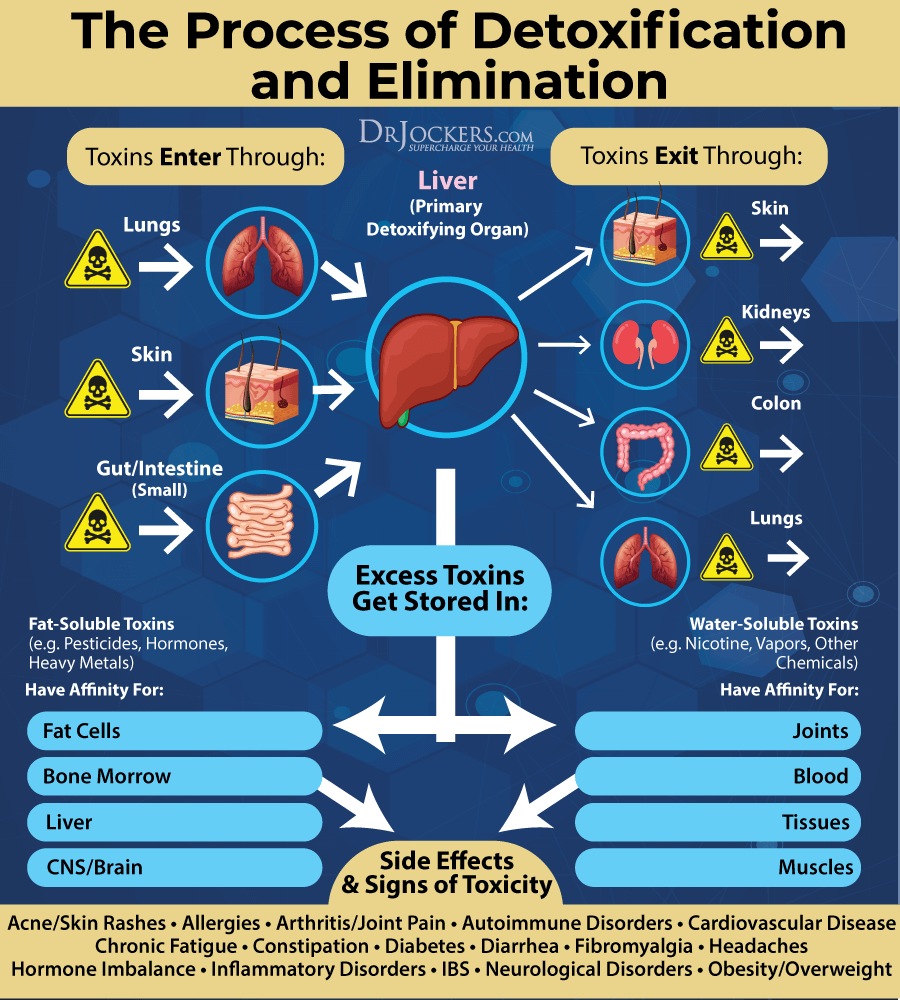
Epsom Salt Baths
Epsom salt baths have been used for hundreds of years by different cultures for their remarkable health benefits. One of these benefits is supporting detoxification. Epsom salt is different from other salts in that it is a naturally occurring pure mineral compound of magnesium and sulfate. These minerals can enhance the body’s detoxification process.
Magnesium is a remarkable mineral that supports blood sugar balance, circulation, cellular energy production, bone density, pain relief, joint and ligament flexibility, deep sleep patterns and more. Epsom salt baths help to improve your body’s magnesium levels and sulfates while removing harmful toxins from the body.
Epsom salt baths are an advanced detoxification strategy with amazing health benefits. Epsom salt baths are also a great way to relax and support mental, emotional, and spiritual health.
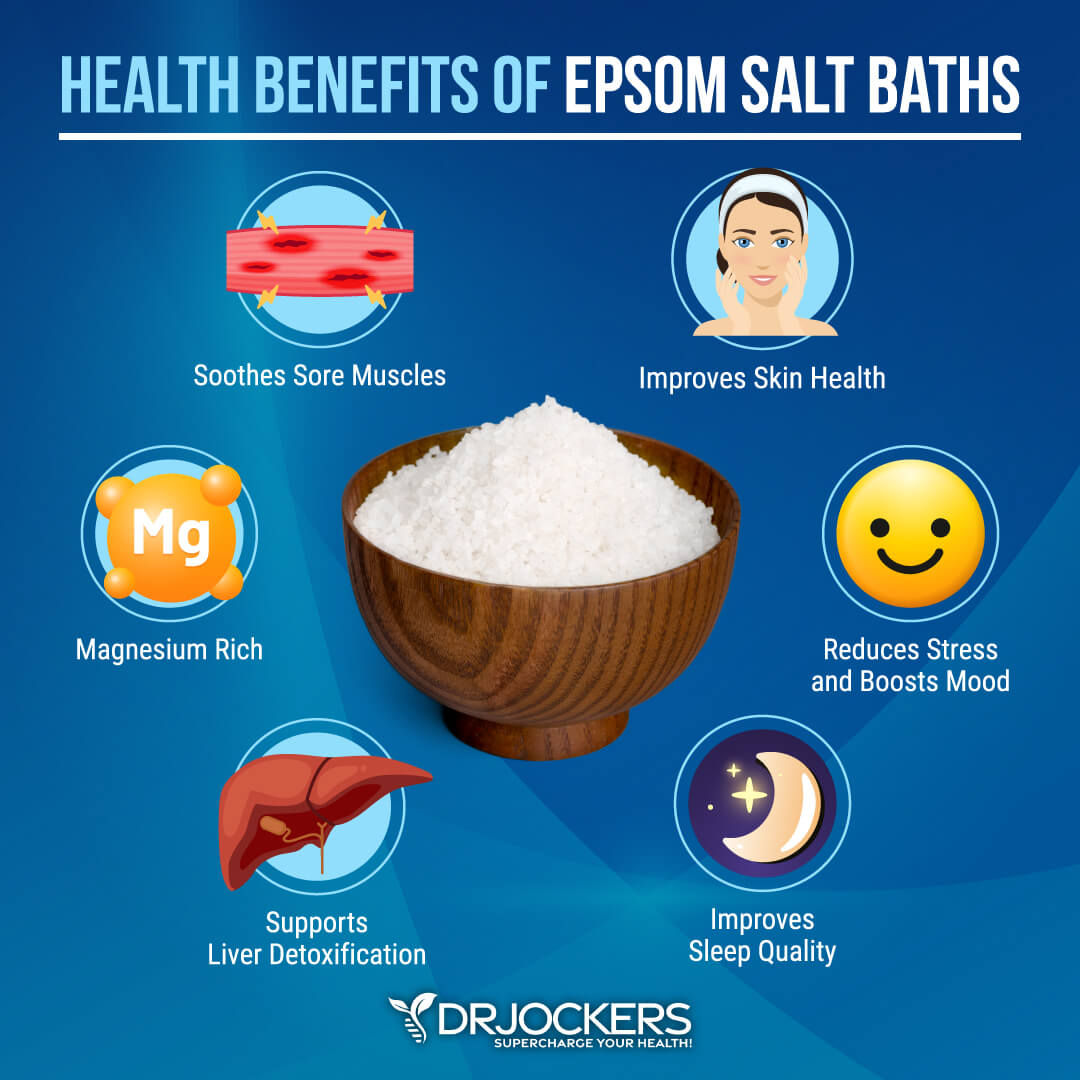
Infrared Sauna
Infrared saunas are superior to other saunas. They are a great way to release toxins through sweating. Far Infrared technology (FIR) is a non-invasive form of light therapy that penetrates the body as much as three inches.
Infrared saunas heat up muscle tissue and internal organs without heating the surrounding air. This helps the organs and tissues push toxins into the blood stream and support elimination through the perspiration process.
Infrared sauna can support various pathways in your body, including liver detoxification metabolic pathways, kidney filtration and elimination and fat cell mobilization. It may also fight pathogens, improve the immune system, decrease stress, and stimulate metabolism which enhances healthy weight loss.
Ideally, you want to use an infrared sauna daily, but if that’s not an option, even a few times a week can do wonders. You may learn more about the benefits of infrared saunas from this article.

Use Chlorella
Chlorella is a fantastic toxin binder. It is a chlorophyll rich algae, that is full of minerals, vitamins, fibers, and amino acids. It can bind to dioxins, which are environmental pollutants released from manufacturing processes and burning garbage.
Chlorella is commonly used to support your body detoxifying from heavy metals, including heavy metals and toxins used in dentistry. According to a 2019 study published in Antioxidants (Basel), chlorella may help to detox from dental heavy metals such as mercury amalgam fillings and titanium implants (62).
It may also help detoxification from fluoride exposure, as in nature, fluoride can reduce chlorella growth due to high uptake (63). According to a 2014 study published in the Chemistry Center Journal, chlorella and other blue-green algae may help to fight fluoride (64). Thus, you may benefit from chlorella supplementation to remove fluoride and other toxins from your body.

Use a Detox Binder
I also recommend using a detox binder supplement, such as GI Detox or HM-ET Binder.
GI Detox is a full spectrum binder that provides a simple solution for environmental and internally produced detoxification. It supports healthy detoxification and full-body cleaning, reduces bloating and gas, helps the clearance of mold metabolites, supports mental clarity, and allows a more pleasant cleansing experience. It is formulated to provide broader activity than a single-ingredient product.
Zeolite clay, activated charcoal, and MMST silica, plus apple pectin, humic and fulvic acids, and aloe vera. Binding and detoxification agents long used in traditional medicine and supported by modern research.
I recommend taking 1 capsule on an empty stomach with a full glass of water or as directed by a healthcare professional. Take 1 hour apart from other medications and supplements.
HM-ET Binder is a microbiome and detox support supplement. It supports the body’s natural ability to detoxify and encourages cellular repair. With the addition of Carbon Technology, it lends increased support to mitochondrial health, immunity, energy production, and long-term health. The name is simple: “HM” comes from “heavy metals” and “ET” comes from “environmental toxins.”
This product is designed to focus on chelating both heavy metals and environmental toxins from the system, while the BioActive Carbon molecules provide the biological building blocks to heal your system.
Carbon Technology is a proprietary blend of fulvic acids that support cellular repair and the body’s natural ability to detoxify. With a low pH, Carbon Technology also helps protect ingredients from being digested by stomach acid, so that they remain intact as they enter the desired location in the body.
HM-ET Binder uses extracts of fulvic and humic acids to help root out environmental toxins (it’s effective in breaking down pesticides, too!) and assist the body in overall wellness, including pain relief, overall healing, and immune system support, and promoting cellular balance as an organic electrolyte.
I recommend taking 1 capsule twice a day between meals, 1 capsule in the morning and 1 capsule in the evening, or as otherwise directed by your healthcare practitioner.
Final Thoughts
Flouride is found in your tap water, conventional toothpaste and dental products, and some of our foods. But all this fluoride may be harming your health and it may carry some researched health risks. It may not be as good for your teeth either as once believed. I recommend that you follow my tips on how to detox from fluoride.
If you want to work with a functional health coach, I recommend this article with tips on how to find a great coach. Our website offers long-distance functional health coaching programs. For further support with your health goals, just reach out and our fantastic coaches are here to support your journey.
Inflammation Crushing Ebundle
The Inflammation Crushing Ebundle is designed to help you improve your brain, liver, immune system and discover the healing strategies, foods and recipes to burn fat, reduce inflammation and Thrive in Life!
As a doctor of natural medicine, I have spent the past 20 years studying the best healing strategies and worked with hundreds of coaching clients, helping them overcome chronic health conditions and optimize their overall health.
In our Inflammation Crushing Ebundle, I have put together my very best strategies to reduce inflammation and optimize your healing potential. Take a look at what you will get inside these valuable guides below!





